


A warm welcome to the inaugural annual Knowledge Management report (2022) conducted by the team here at Scrintal – the one tool to go from brainstorming to presentable work – from various proprietary surveys completed by more than 5,000 knowledge workers like you, across various professional roles including:
☑️ Consultants
☑️ Executives
☑️ Founders
☑️ Marketers
☑️ Developers
☑️ Students
☑️ Researchers
☑️ Designers
☑️ Writers
…and more!
We’ve captured the wants, needs and preferences of a diverse group of knowledge management and tools for thoughts enthusiasts across the globe to produce this comprehensive report and publish statistics that we’ll continue to track, measure, and review over the coming years.
A warm welcome to the inaugural annual Knowledge Management report (2022) conducted by the team here at Scrintal – the one tool to go from brainstorming to presentable work – from various proprietary surveys completed by more than 5,000 knowledge workers like you, across various professional roles including:
☑️ Consultants
☑️ Executives
☑️ Founders
☑️ Marketers
☑️ Developers
☑️ Students
☑️ Researchers
☑️ Designers
☑️ Writers
…and more!
We’ve captured the wants, needs and preferences of a diverse group of knowledge management and tools for thoughts enthusiasts across the globe to produce this comprehensive report and publish statistics that we’ll continue to track, measure, and review over the coming years.
A warm welcome to the inaugural annual Knowledge Management report (2022) conducted by the team here at Scrintal – the one tool to go from brainstorming to presentable work – from various proprietary surveys completed by more than 5,000 knowledge workers like you, across various professional roles including:
☑️ Consultants
☑️ Executives
☑️ Founders
☑️ Marketers
☑️ Developers
☑️ Students
☑️ Researchers
☑️ Designers
☑️ Writers
…and more!
We’ve captured the wants, needs and preferences of a diverse group of knowledge management and tools for thoughts enthusiasts across the globe to produce this comprehensive report and publish statistics that we’ll continue to track, measure, and review over the coming years.
A warm welcome to the inaugural annual Knowledge Management report (2022) conducted by the team here at Scrintal – the one tool to go from brainstorming to presentable work – from various proprietary surveys completed by more than 5,000 knowledge workers like you, across various professional roles including:
☑️ Consultants
☑️ Executives
☑️ Founders
☑️ Marketers
☑️ Developers
☑️ Students
☑️ Researchers
☑️ Designers
☑️ Writers
…and more!
We’ve captured the wants, needs and preferences of a diverse group of knowledge management and tools for thoughts enthusiasts across the globe to produce this comprehensive report and publish statistics that we’ll continue to track, measure, and review over the coming years.
A warm welcome to the inaugural annual Knowledge Management report (2022) conducted by the team here at Scrintal – the one tool to go from brainstorming to presentable work – from various proprietary surveys completed by more than 5,000 knowledge workers like you, across various professional roles including:
☑️ Consultants
☑️ Executives
☑️ Founders
☑️ Marketers
☑️ Developers
☑️ Students
☑️ Researchers
☑️ Designers
☑️ Writers
…and more!
We’ve captured the wants, needs and preferences of a diverse group of knowledge management and tools for thoughts enthusiasts across the globe to produce this comprehensive report and publish statistics that we’ll continue to track, measure, and review over the coming years.
Knowledge Management (KM)
The roots of (personal) knowledge management are multidisciplinary (Pauleen, 2009). One of the more apparent roots is personal information management (PIM), stemming from research in library and information management and personal productivity tools management developed quickly in response to the technology revolution and the resulting problem of information overload (Jefferson, 2006).
Early work in this area focused on helping university students develop information literacy skills and use technology to organise, retain and use information (Frand and Hixon, 1999; Avery et al., 2001). Much of this history in knowledge management is covered in greater detail in some of the articles presented in this theme issue of Online Information Review (e.g. Agnihotri and Troutt).
The technological approach may be considered limited at present, as there seems to be no end to the amount of available information, and technology has proved to be more effective in producing more information than in managing it. Other more recent and multidisciplinary approaches to knowledge management (though not always explicitly acknowledging knowledge management) have focused on the development of skills and attitudes that lead to more effective cognition, communication, collaboration, creativity, problem solving, lifelong learning, social networking, leadership and the like.
These approaches take knowledge management to a higher level than information management and can help individuals better understand information and knowledge and put them into a context that, among other things, allows more effective decision making (Zuber-Skerritt, 2005; Dorsey, 2000; Jefferson, 2006).*
*The excerpt has been adapted from Professor David J. Pauleen, Personal knowledge management: Putting the 'person' back into the knowledge equation. 2009.
The roots of (personal) knowledge management are multidisciplinary (Pauleen, 2009). One of the more apparent roots is personal information management (PIM), stemming from research in library and information management and personal productivity tools management developed quickly in response to the technology revolution and the resulting problem of information overload (Jefferson, 2006).
Early work in this area focused on helping university students develop information literacy skills and use technology to organise, retain and use information (Frand and Hixon, 1999; Avery et al., 2001). Much of this history in knowledge management is covered in greater detail in some of the articles presented in this theme issue of Online Information Review (e.g. Agnihotri and Troutt).
The technological approach may be considered limited at present, as there seems to be no end to the amount of available information, and technology has proved to be more effective in producing more information than in managing it. Other more recent and multidisciplinary approaches to knowledge management (though not always explicitly acknowledging knowledge management) have focused on the development of skills and attitudes that lead to more effective cognition, communication, collaboration, creativity, problem solving, lifelong learning, social networking, leadership and the like.
These approaches take knowledge management to a higher level than information management and can help individuals better understand information and knowledge and put them into a context that, among other things, allows more effective decision making (Zuber-Skerritt, 2005; Dorsey, 2000; Jefferson, 2006).*
*The excerpt has been adapted from Professor David J. Pauleen, Personal knowledge management: Putting the 'person' back into the knowledge equation. 2009.
The roots of (personal) knowledge management are multidisciplinary (Pauleen, 2009). One of the more apparent roots is personal information management (PIM), stemming from research in library and information management and personal productivity tools management developed quickly in response to the technology revolution and the resulting problem of information overload (Jefferson, 2006).
Early work in this area focused on helping university students develop information literacy skills and use technology to organise, retain and use information (Frand and Hixon, 1999; Avery et al., 2001). Much of this history in knowledge management is covered in greater detail in some of the articles presented in this theme issue of Online Information Review (e.g. Agnihotri and Troutt).
The technological approach may be considered limited at present, as there seems to be no end to the amount of available information, and technology has proved to be more effective in producing more information than in managing it. Other more recent and multidisciplinary approaches to knowledge management (though not always explicitly acknowledging knowledge management) have focused on the development of skills and attitudes that lead to more effective cognition, communication, collaboration, creativity, problem solving, lifelong learning, social networking, leadership and the like.
These approaches take knowledge management to a higher level than information management and can help individuals better understand information and knowledge and put them into a context that, among other things, allows more effective decision making (Zuber-Skerritt, 2005; Dorsey, 2000; Jefferson, 2006).*
*The excerpt has been adapted from Professor David J. Pauleen, Personal knowledge management: Putting the 'person' back into the knowledge equation. 2009.
The roots of (personal) knowledge management are multidisciplinary (Pauleen, 2009). One of the more apparent roots is personal information management (PIM), stemming from research in library and information management and personal productivity tools management developed quickly in response to the technology revolution and the resulting problem of information overload (Jefferson, 2006).
Early work in this area focused on helping university students develop information literacy skills and use technology to organise, retain and use information (Frand and Hixon, 1999; Avery et al., 2001). Much of this history in knowledge management is covered in greater detail in some of the articles presented in this theme issue of Online Information Review (e.g. Agnihotri and Troutt).
The technological approach may be considered limited at present, as there seems to be no end to the amount of available information, and technology has proved to be more effective in producing more information than in managing it. Other more recent and multidisciplinary approaches to knowledge management (though not always explicitly acknowledging knowledge management) have focused on the development of skills and attitudes that lead to more effective cognition, communication, collaboration, creativity, problem solving, lifelong learning, social networking, leadership and the like.
These approaches take knowledge management to a higher level than information management and can help individuals better understand information and knowledge and put them into a context that, among other things, allows more effective decision making (Zuber-Skerritt, 2005; Dorsey, 2000; Jefferson, 2006).*
*The excerpt has been adapted from Professor David J. Pauleen, Personal knowledge management: Putting the 'person' back into the knowledge equation. 2009.
The roots of (personal) knowledge management are multidisciplinary (Pauleen, 2009). One of the more apparent roots is personal information management (PIM), stemming from research in library and information management and personal productivity tools management developed quickly in response to the technology revolution and the resulting problem of information overload (Jefferson, 2006).
Early work in this area focused on helping university students develop information literacy skills and use technology to organise, retain and use information (Frand and Hixon, 1999; Avery et al., 2001). Much of this history in knowledge management is covered in greater detail in some of the articles presented in this theme issue of Online Information Review (e.g. Agnihotri and Troutt).
The technological approach may be considered limited at present, as there seems to be no end to the amount of available information, and technology has proved to be more effective in producing more information than in managing it. Other more recent and multidisciplinary approaches to knowledge management (though not always explicitly acknowledging knowledge management) have focused on the development of skills and attitudes that lead to more effective cognition, communication, collaboration, creativity, problem solving, lifelong learning, social networking, leadership and the like.
These approaches take knowledge management to a higher level than information management and can help individuals better understand information and knowledge and put them into a context that, among other things, allows more effective decision making (Zuber-Skerritt, 2005; Dorsey, 2000; Jefferson, 2006).*
*The excerpt has been adapted from Professor David J. Pauleen, Personal knowledge management: Putting the 'person' back into the knowledge equation. 2009.
Demographics
Job Titles
We asked the survey respondents to answer with their personal or professional role title they are closest related to at present and below were the popular answers across the board with the larger words the more respondents identify as the role. We have noticed an academic bias towards knowledge management usage with students (of varying education levels) and researchers (including PhD), including private sector actors such as consultants and executives being key proponents of system adoption.
☑️ Students and academics
☑️ Consultants
☑️ Executives
Business or Personal Use
We asked respondents how they use knowledge management tools primarily. We saw a strong response for blending personal and professional activities and for personal use rather than solely business use.

Device of Choice
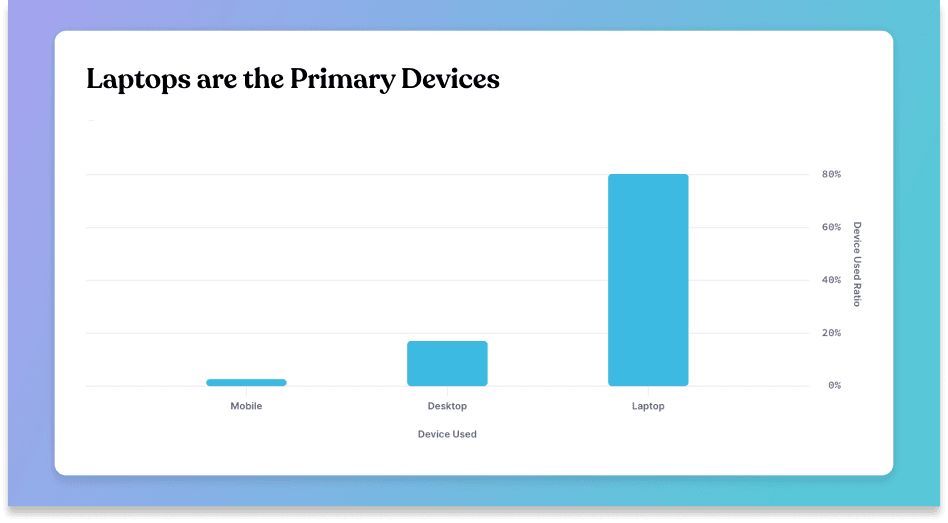
Browser of Choice
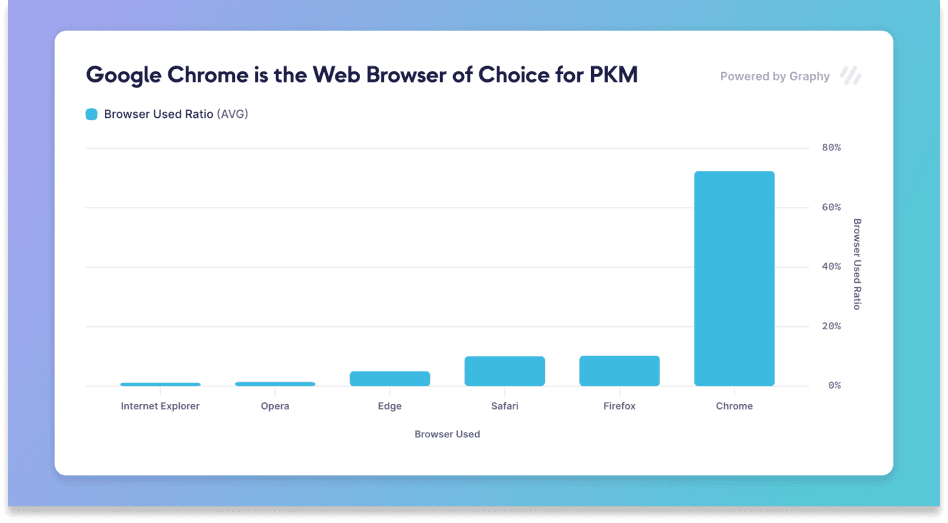
Job Titles
We asked the survey respondents to answer with their personal or professional role title they are closest related to at present and below were the popular answers across the board with the larger words the more respondents identify as the role. We have noticed an academic bias towards knowledge management usage with students (of varying education levels) and researchers (including PhD), including private sector actors such as consultants and executives being key proponents of system adoption.
☑️ Students and academics
☑️ Consultants
☑️ Executives
Business or Personal Use
We asked respondents how they use knowledge management tools primarily. We saw a strong response for blending personal and professional activities and for personal use rather than solely business use.

Device of Choice

Browser of Choice

Job Titles
We asked the survey respondents to answer with their personal or professional role title they are closest related to at present and below were the popular answers across the board with the larger words the more respondents identify as the role. We have noticed an academic bias towards knowledge management usage with students (of varying education levels) and researchers (including PhD), including private sector actors such as consultants and executives being key proponents of system adoption.
☑️ Students and academics
☑️ Consultants
☑️ Executives
Business or Personal Use
We asked respondents how they use knowledge management tools primarily. We saw a strong response for blending personal and professional activities and for personal use rather than solely business use.

Device of Choice

Browser of Choice

Job Titles
We asked the survey respondents to answer with their personal or professional role title they are closest related to at present and below were the popular answers across the board with the larger words the more respondents identify as the role. We have noticed an academic bias towards knowledge management usage with students (of varying education levels) and researchers (including PhD), including private sector actors such as consultants and executives being key proponents of system adoption.
☑️ Students and academics
☑️ Consultants
☑️ Executives
Business or Personal Use
We asked respondents how they use knowledge management tools primarily. We saw a strong response for blending personal and professional activities and for personal use rather than solely business use.

Device of Choice

Browser of Choice

Job Titles
We asked the survey respondents to answer with their personal or professional role title they are closest related to at present and below were the popular answers across the board with the larger words the more respondents identify as the role. We have noticed an academic bias towards knowledge management usage with students (of varying education levels) and researchers (including PhD), including private sector actors such as consultants and executives being key proponents of system adoption.
☑️ Students and academics
☑️ Consultants
☑️ Executives
Business or Personal Use
We asked respondents how they use knowledge management tools primarily. We saw a strong response for blending personal and professional activities and for personal use rather than solely business use.

Device of Choice

Browser of Choice

Users’ Knowledge Management Needs
Knowledge Management Activities
There are Wide Variety of Reasons for Knowledge Management, Note Taking, and Visual Working.

Knowledge Management Use Cases
Connecting Ideas & Sources is the Most Popular Use Case for Knowledge Management.
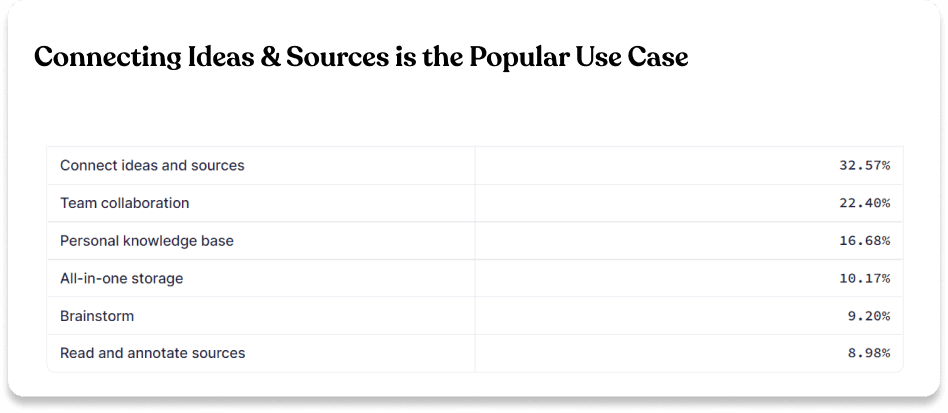
Scrintal Specific Use Cases
We asked the survey respondents which activities they would like to use Scrintal for and the following words represent the popularity that featured in their answers. Writing and project management were the two main featured terms in the answers, shortly followed by ideating, researching, studying, planning and note taking (in no particular order).

Visual Tool Use Cases
Similarly to the previous question, survey respondents answered why they typically choose to use visual software and here were the following popular words that featured in their answers. If we connected this word cloud with the previous question, as Scrintal is a highly visual tool, then we could deduce from the data that Project Management and Mind Mapping are inextricably linked.

Knowledge Management Needs
Making Sense of Collected Information is a Primary Need.
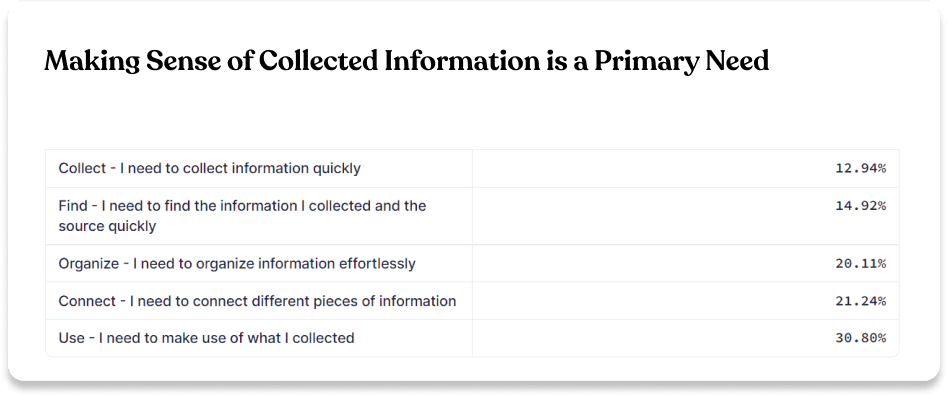
Challenges of Multi-Source Data
Finding the sources of information is the most popular information gathering challenge.
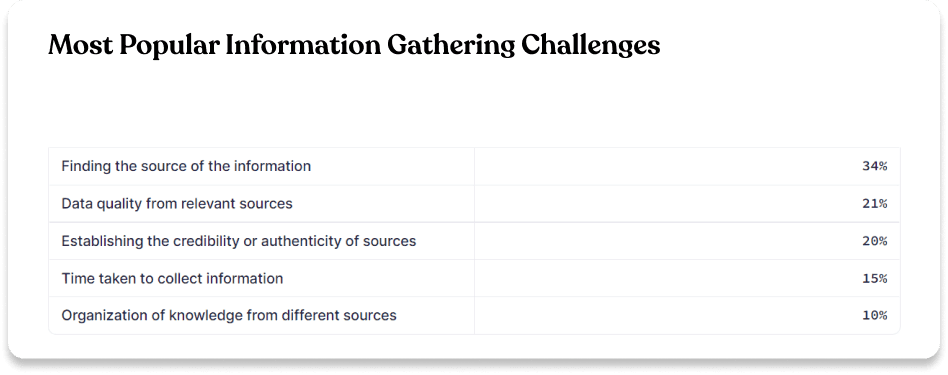
Knowledge Management Activities
There are Wide Variety of Reasons for Knowledge Management, Note Taking, and Visual Working.

Knowledge Management Use Cases
Connecting Ideas & Sources is the Most Popular Use Case for Knowledge Management.

Scrintal Specific Use Cases
We asked the survey respondents which activities they would like to use Scrintal for and the following words represent the popularity that featured in their answers. Writing and project management were the two main featured terms in the answers, shortly followed by ideating, researching, studying, planning and note taking (in no particular order).

Visual Tool Use Cases
Similarly to the previous question, survey respondents answered why they typically choose to use visual software and here were the following popular words that featured in their answers. If we connected this word cloud with the previous question, as Scrintal is a highly visual tool, then we could deduce from the data that Project Management and Mind Mapping are inextricably linked.

Knowledge Management Needs
Making Sense of Collected Information is a Primary Need.

Challenges of Multi-Source Data
Finding the sources of information is the most popular information gathering challenge.

Knowledge Management Activities
There are Wide Variety of Reasons for Knowledge Management, Note Taking, and Visual Working.

Knowledge Management Use Cases
Connecting Ideas & Sources is the Most Popular Use Case for Knowledge Management.

Scrintal Specific Use Cases
We asked the survey respondents which activities they would like to use Scrintal for and the following words represent the popularity that featured in their answers. Writing and project management were the two main featured terms in the answers, shortly followed by ideating, researching, studying, planning and note taking (in no particular order).

Visual Tool Use Cases
Similarly to the previous question, survey respondents answered why they typically choose to use visual software and here were the following popular words that featured in their answers. If we connected this word cloud with the previous question, as Scrintal is a highly visual tool, then we could deduce from the data that Project Management and Mind Mapping are inextricably linked.

Knowledge Management Needs
Making Sense of Collected Information is a Primary Need.

Challenges of Multi-Source Data
Finding the sources of information is the most popular information gathering challenge.

Knowledge Management Activities
There are Wide Variety of Reasons for Knowledge Management, Note Taking, and Visual Working.

Knowledge Management Use Cases
Connecting Ideas & Sources is the Most Popular Use Case for Knowledge Management.

Scrintal Specific Use Cases
We asked the survey respondents which activities they would like to use Scrintal for and the following words represent the popularity that featured in their answers. Writing and project management were the two main featured terms in the answers, shortly followed by ideating, researching, studying, planning and note taking (in no particular order).

Visual Tool Use Cases
Similarly to the previous question, survey respondents answered why they typically choose to use visual software and here were the following popular words that featured in their answers. If we connected this word cloud with the previous question, as Scrintal is a highly visual tool, then we could deduce from the data that Project Management and Mind Mapping are inextricably linked.

Knowledge Management Needs
Making Sense of Collected Information is a Primary Need.

Challenges of Multi-Source Data
Finding the sources of information is the most popular information gathering challenge.

Knowledge Management Activities
There are Wide Variety of Reasons for Knowledge Management, Note Taking, and Visual Working.

Knowledge Management Use Cases
Connecting Ideas & Sources is the Most Popular Use Case for Knowledge Management.

Scrintal Specific Use Cases
We asked the survey respondents which activities they would like to use Scrintal for and the following words represent the popularity that featured in their answers. Writing and project management were the two main featured terms in the answers, shortly followed by ideating, researching, studying, planning and note taking (in no particular order).

Visual Tool Use Cases
Similarly to the previous question, survey respondents answered why they typically choose to use visual software and here were the following popular words that featured in their answers. If we connected this word cloud with the previous question, as Scrintal is a highly visual tool, then we could deduce from the data that Project Management and Mind Mapping are inextricably linked.

Knowledge Management Needs
Making Sense of Collected Information is a Primary Need.

Challenges of Multi-Source Data
Finding the sources of information is the most popular information gathering challenge.

User Behaviour in Knowledge Management
Roam Research is the most common knowledge management tool previously tried.
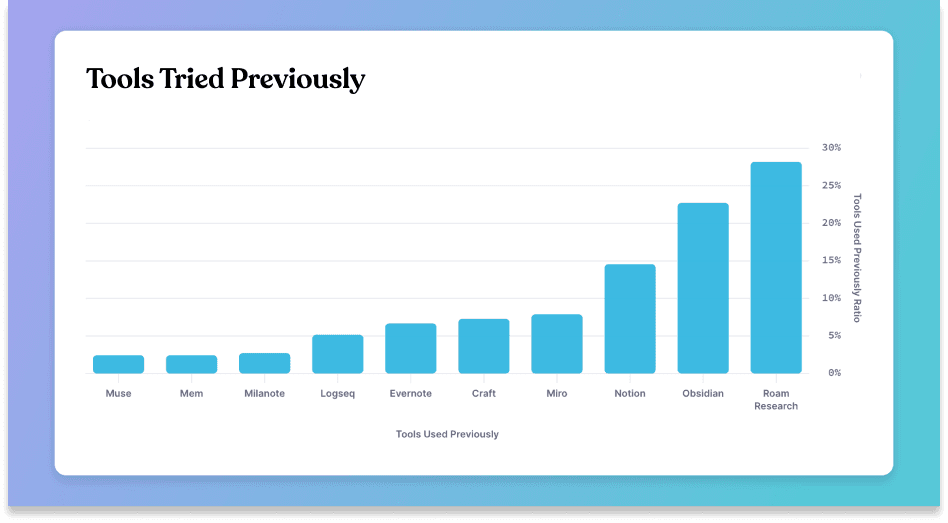
Knowledge Management Tools Currently Used
Notion is the most used tool currently.
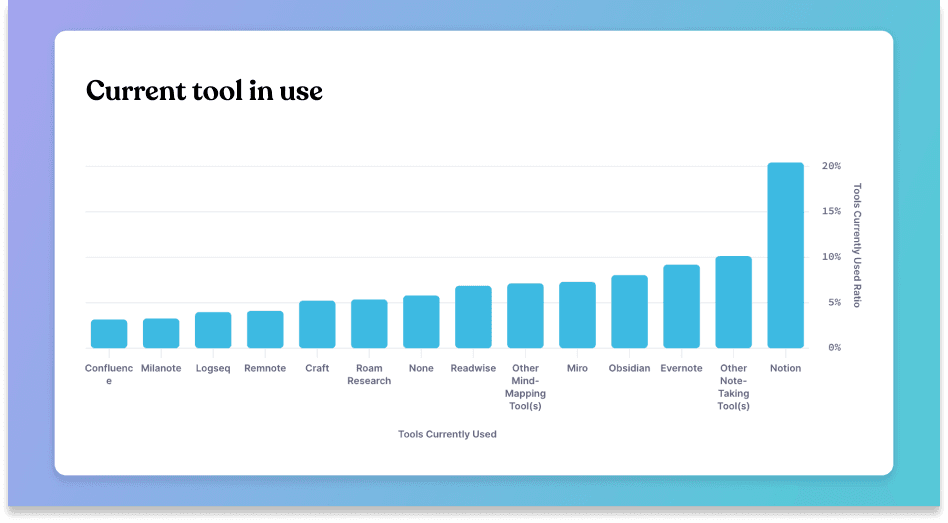
Knowledge Management Feature Expectations
The Most Popular Expectations from knowledge management tools are beautiful UI, templates and a mobile application.
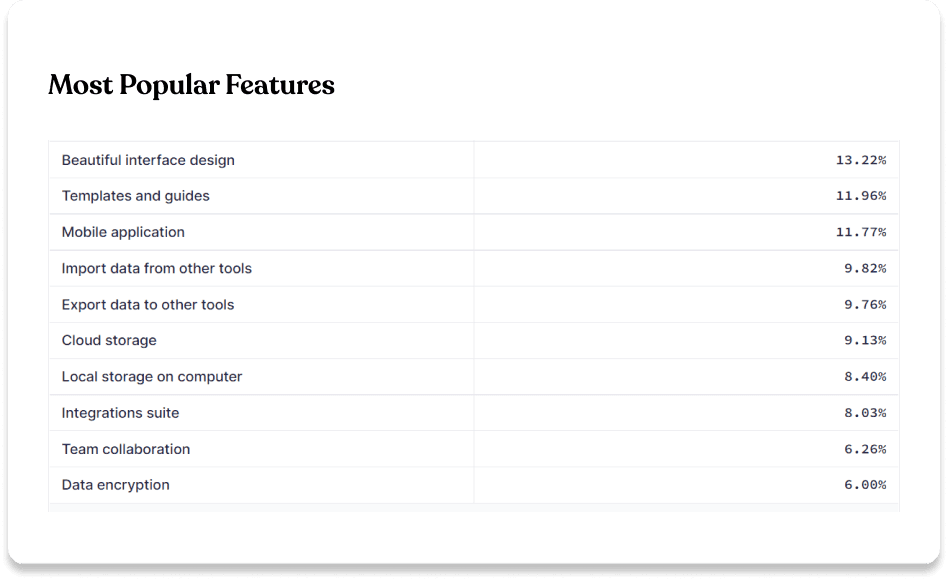
Simplicity or Feature Set?
More than 60% of our respondents prefer tools with a simple and beautiful design to comprehensive feature sets.
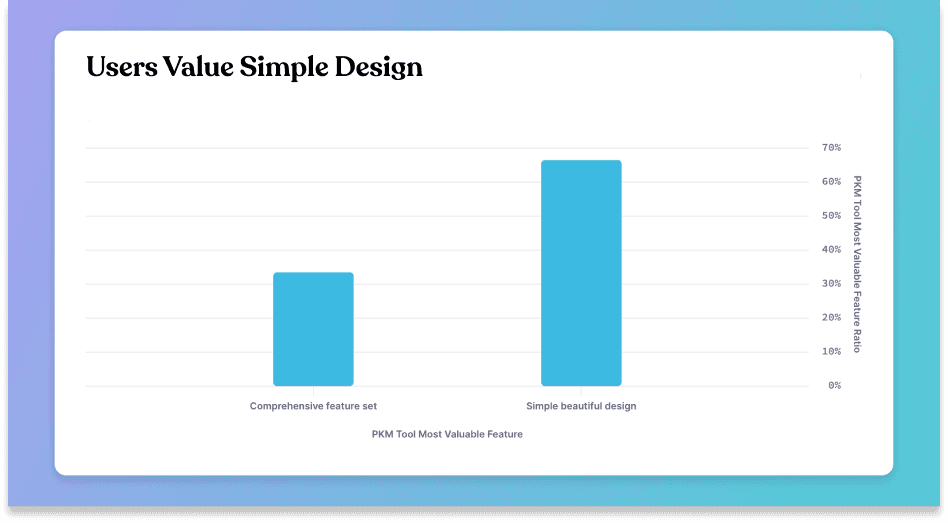
Onboarding Preferences
More than 60% of knowledge management users want to be onboarded to a new tool by watching tutorial videos.
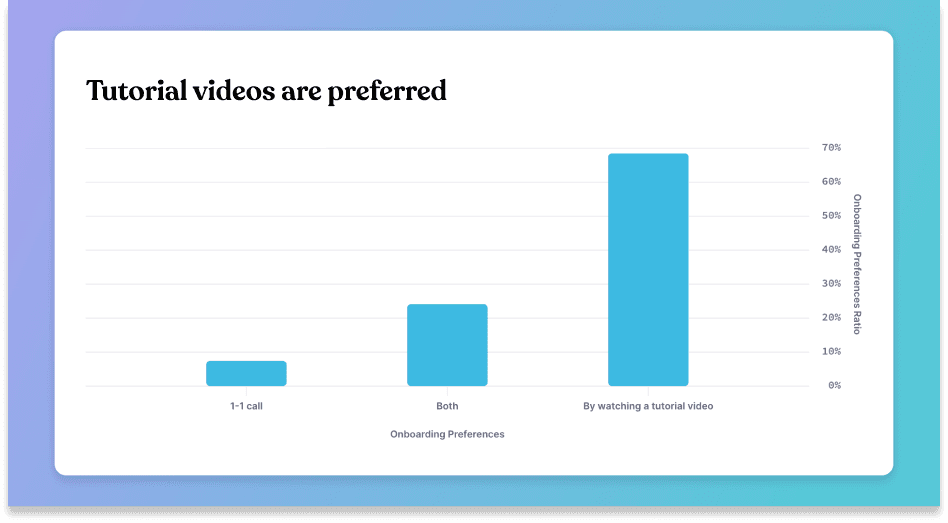
How Users Prefer to be Onboarded to Knowledge Management Tools in More Detail
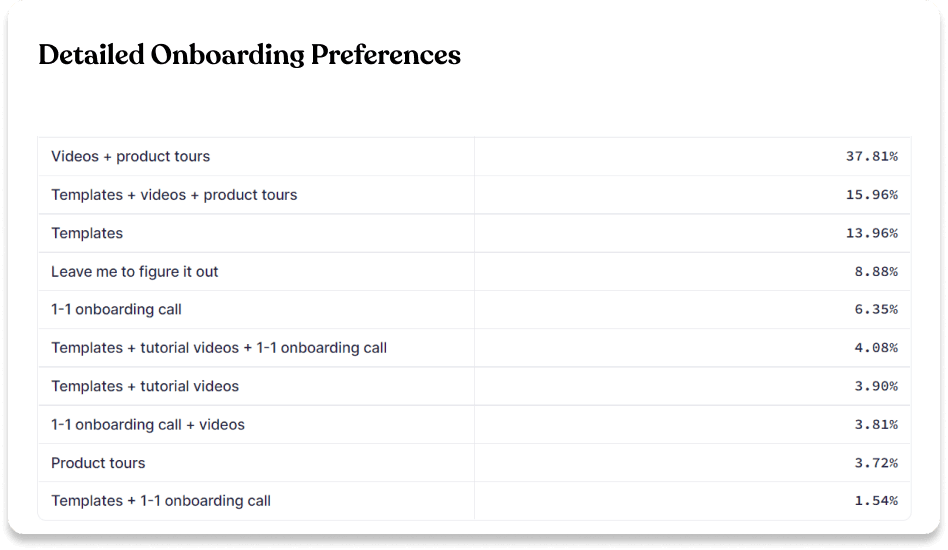
Publishing Written Content
70% of respondents stated that they publish the information they produce in knowledge management tools.
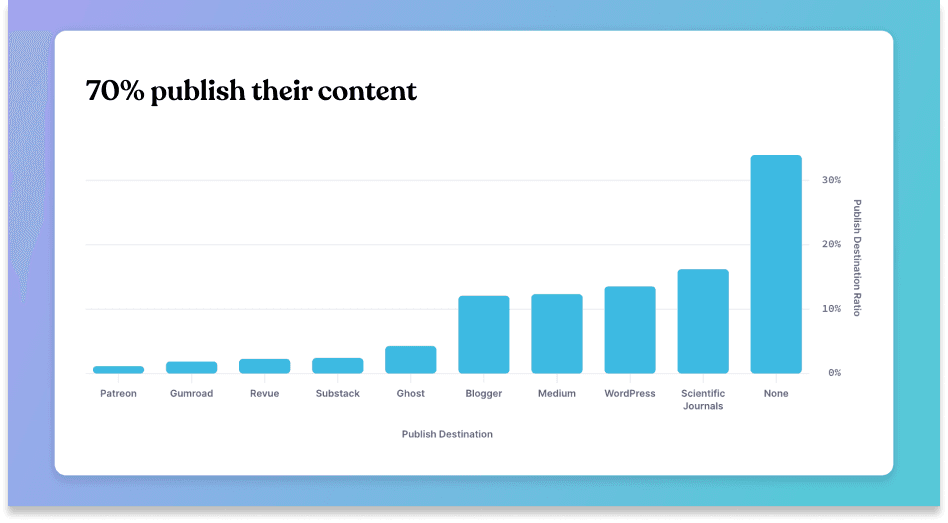
Roam Research is the most common knowledge management tool previously tried.

Knowledge Management Tools Currently Used
Notion is the most used tool currently.

Knowledge Management Feature Expectations
The Most Popular Expectations from knowledge management tools are beautiful UI, templates and a mobile application.

Simplicity or Feature Set?
More than 60% of our respondents prefer tools with a simple and beautiful design to comprehensive feature sets.

Onboarding Preferences
More than 60% of knowledge management users want to be onboarded to a new tool by watching tutorial videos.

How Users Prefer to be Onboarded to Knowledge Management Tools in More Detail

Publishing Written Content
70% of respondents stated that they publish the information they produce in knowledge management tools.

Roam Research is the most common knowledge management tool previously tried.

Knowledge Management Tools Currently Used
Notion is the most used tool currently.

Knowledge Management Feature Expectations
The Most Popular Expectations from knowledge management tools are beautiful UI, templates and a mobile application.

Simplicity or Feature Set?
More than 60% of our respondents prefer tools with a simple and beautiful design to comprehensive feature sets.

Onboarding Preferences
More than 60% of knowledge management users want to be onboarded to a new tool by watching tutorial videos.

How Users Prefer to be Onboarded to Knowledge Management Tools in More Detail

Publishing Written Content
70% of respondents stated that they publish the information they produce in knowledge management tools.

Roam Research is the most common knowledge management tool previously tried.

Knowledge Management Tools Currently Used
Notion is the most used tool currently.

Knowledge Management Feature Expectations
The Most Popular Expectations from knowledge management tools are beautiful UI, templates and a mobile application.

Simplicity or Feature Set?
More than 60% of our respondents prefer tools with a simple and beautiful design to comprehensive feature sets.

Onboarding Preferences
More than 60% of knowledge management users want to be onboarded to a new tool by watching tutorial videos.

How Users Prefer to be Onboarded to Knowledge Management Tools in More Detail

Publishing Written Content
70% of respondents stated that they publish the information they produce in knowledge management tools.

Roam Research is the most common knowledge management tool previously tried.

Knowledge Management Tools Currently Used
Notion is the most used tool currently.

Knowledge Management Feature Expectations
The Most Popular Expectations from knowledge management tools are beautiful UI, templates and a mobile application.

Simplicity or Feature Set?
More than 60% of our respondents prefer tools with a simple and beautiful design to comprehensive feature sets.

Onboarding Preferences
More than 60% of knowledge management users want to be onboarded to a new tool by watching tutorial videos.

How Users Prefer to be Onboarded to Knowledge Management Tools in More Detail

Publishing Written Content
70% of respondents stated that they publish the information they produce in knowledge management tools.

Conclusion
Hopefully you found the 2022 Personal Knowledge Management Report as insightful as we have here at Scrintal, there were some interesting results throughout, some of which we really weren’t expecting at all. We’re enthused by how engaged the global knowledge management community is and we’ll be back bigger and better for the 2023 report.
Let’s conclude with a summary of highlights;
1. Reading, note taking, visualising thinking and capturing ideas form 52% of the activities involved in knowledge management,
2. Even though some knowledge workers work alone, they are still interested in Team Collaboration which took 2nd place in the popular feature requirements. Trumped only by having the ability to connect ideas and sources in a visual way.
3. The most frustrating part of knowledge management is finding the true source of information as well as ensuring the validity of data from relevant sources.
4. Roam Research, Obsidian and Notion are highly tested knowledge management tools but it’s Notion that leads the way with tools still actively used, thus deducing that Roam and Obsidian aren’t meeting user needs with a higher barrier to entry or difficulty using.
5. Whilst there are an abundance of knowledge management tool features, it was clear that a beautiful interface design trumps all, alongside the need for templates and guides. Followed only by having a mobile application to be able to manage knowledge on the go.
6. It’s fair to say that knowledge management users are avid self-learners by nature considering their onboarding preferences are heavily biased towards watching tutorials in the form of videos and product tours.
7. Most surprisingly, 70% of knowledge management users publish their work online.
Overall, we can conclude that the greatest need for knowledge workers is for them to, quite simply, be able to make sense of all the knowledge they create. Gathering all this information, Scrintal is being developed as a differentiator among the tools for thought and mind mapping. We focus on three differentiating factors for Scrintal; no rigid folder structure as opposed to standard knowledge management systems, treating visuality as a first class citizen, and focus on collaboration and sharing.
Hopefully you found the 2022 Personal Knowledge Management Report as insightful as we have here at Scrintal, there were some interesting results throughout, some of which we really weren’t expecting at all. We’re enthused by how engaged the global knowledge management community is and we’ll be back bigger and better for the 2023 report.
Let’s conclude with a summary of highlights;
1. Reading, note taking, visualising thinking and capturing ideas form 52% of the activities involved in knowledge management,
2. Even though some knowledge workers work alone, they are still interested in Team Collaboration which took 2nd place in the popular feature requirements. Trumped only by having the ability to connect ideas and sources in a visual way.
3. The most frustrating part of knowledge management is finding the true source of information as well as ensuring the validity of data from relevant sources.
4. Roam Research, Obsidian and Notion are highly tested knowledge management tools but it’s Notion that leads the way with tools still actively used, thus deducing that Roam and Obsidian aren’t meeting user needs with a higher barrier to entry or difficulty using.
5. Whilst there are an abundance of knowledge management tool features, it was clear that a beautiful interface design trumps all, alongside the need for templates and guides. Followed only by having a mobile application to be able to manage knowledge on the go.
6. It’s fair to say that knowledge management users are avid self-learners by nature considering their onboarding preferences are heavily biased towards watching tutorials in the form of videos and product tours.
7. Most surprisingly, 70% of knowledge management users publish their work online.
Overall, we can conclude that the greatest need for knowledge workers is for them to, quite simply, be able to make sense of all the knowledge they create. Gathering all this information, Scrintal is being developed as a differentiator among the tools for thought and mind mapping. We focus on three differentiating factors for Scrintal; no rigid folder structure as opposed to standard knowledge management systems, treating visuality as a first class citizen, and focus on collaboration and sharing.
Hopefully you found the 2022 Personal Knowledge Management Report as insightful as we have here at Scrintal, there were some interesting results throughout, some of which we really weren’t expecting at all. We’re enthused by how engaged the global knowledge management community is and we’ll be back bigger and better for the 2023 report.
Let’s conclude with a summary of highlights;
1. Reading, note taking, visualising thinking and capturing ideas form 52% of the activities involved in knowledge management,
2. Even though some knowledge workers work alone, they are still interested in Team Collaboration which took 2nd place in the popular feature requirements. Trumped only by having the ability to connect ideas and sources in a visual way.
3. The most frustrating part of knowledge management is finding the true source of information as well as ensuring the validity of data from relevant sources.
4. Roam Research, Obsidian and Notion are highly tested knowledge management tools but it’s Notion that leads the way with tools still actively used, thus deducing that Roam and Obsidian aren’t meeting user needs with a higher barrier to entry or difficulty using.
5. Whilst there are an abundance of knowledge management tool features, it was clear that a beautiful interface design trumps all, alongside the need for templates and guides. Followed only by having a mobile application to be able to manage knowledge on the go.
6. It’s fair to say that knowledge management users are avid self-learners by nature considering their onboarding preferences are heavily biased towards watching tutorials in the form of videos and product tours.
7. Most surprisingly, 70% of knowledge management users publish their work online.
Overall, we can conclude that the greatest need for knowledge workers is for them to, quite simply, be able to make sense of all the knowledge they create. Gathering all this information, Scrintal is being developed as a differentiator among the tools for thought and mind mapping. We focus on three differentiating factors for Scrintal; no rigid folder structure as opposed to standard knowledge management systems, treating visuality as a first class citizen, and focus on collaboration and sharing.
Hopefully you found the 2022 Personal Knowledge Management Report as insightful as we have here at Scrintal, there were some interesting results throughout, some of which we really weren’t expecting at all. We’re enthused by how engaged the global knowledge management community is and we’ll be back bigger and better for the 2023 report.
Let’s conclude with a summary of highlights;
1. Reading, note taking, visualising thinking and capturing ideas form 52% of the activities involved in knowledge management,
2. Even though some knowledge workers work alone, they are still interested in Team Collaboration which took 2nd place in the popular feature requirements. Trumped only by having the ability to connect ideas and sources in a visual way.
3. The most frustrating part of knowledge management is finding the true source of information as well as ensuring the validity of data from relevant sources.
4. Roam Research, Obsidian and Notion are highly tested knowledge management tools but it’s Notion that leads the way with tools still actively used, thus deducing that Roam and Obsidian aren’t meeting user needs with a higher barrier to entry or difficulty using.
5. Whilst there are an abundance of knowledge management tool features, it was clear that a beautiful interface design trumps all, alongside the need for templates and guides. Followed only by having a mobile application to be able to manage knowledge on the go.
6. It’s fair to say that knowledge management users are avid self-learners by nature considering their onboarding preferences are heavily biased towards watching tutorials in the form of videos and product tours.
7. Most surprisingly, 70% of knowledge management users publish their work online.
Overall, we can conclude that the greatest need for knowledge workers is for them to, quite simply, be able to make sense of all the knowledge they create. Gathering all this information, Scrintal is being developed as a differentiator among the tools for thought and mind mapping. We focus on three differentiating factors for Scrintal; no rigid folder structure as opposed to standard knowledge management systems, treating visuality as a first class citizen, and focus on collaboration and sharing.
Hopefully you found the 2022 Personal Knowledge Management Report as insightful as we have here at Scrintal, there were some interesting results throughout, some of which we really weren’t expecting at all. We’re enthused by how engaged the global knowledge management community is and we’ll be back bigger and better for the 2023 report.
Let’s conclude with a summary of highlights;
1. Reading, note taking, visualising thinking and capturing ideas form 52% of the activities involved in knowledge management,
2. Even though some knowledge workers work alone, they are still interested in Team Collaboration which took 2nd place in the popular feature requirements. Trumped only by having the ability to connect ideas and sources in a visual way.
3. The most frustrating part of knowledge management is finding the true source of information as well as ensuring the validity of data from relevant sources.
4. Roam Research, Obsidian and Notion are highly tested knowledge management tools but it’s Notion that leads the way with tools still actively used, thus deducing that Roam and Obsidian aren’t meeting user needs with a higher barrier to entry or difficulty using.
5. Whilst there are an abundance of knowledge management tool features, it was clear that a beautiful interface design trumps all, alongside the need for templates and guides. Followed only by having a mobile application to be able to manage knowledge on the go.
6. It’s fair to say that knowledge management users are avid self-learners by nature considering their onboarding preferences are heavily biased towards watching tutorials in the form of videos and product tours.
7. Most surprisingly, 70% of knowledge management users publish their work online.
Overall, we can conclude that the greatest need for knowledge workers is for them to, quite simply, be able to make sense of all the knowledge they create. Gathering all this information, Scrintal is being developed as a differentiator among the tools for thought and mind mapping. We focus on three differentiating factors for Scrintal; no rigid folder structure as opposed to standard knowledge management systems, treating visuality as a first class citizen, and focus on collaboration and sharing.
Unlock brilliance
Company
Guides
Comparisons
Unlock brilliance
Company
Guides
Comparisons
Unlock brilliance
Company
Guides
Comparisons